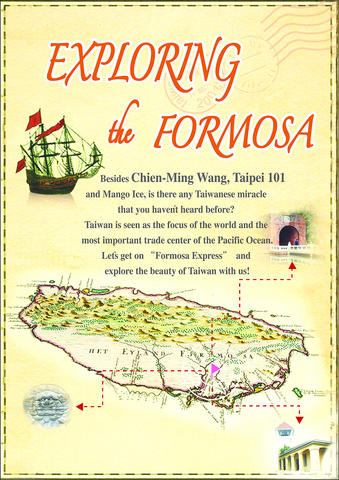To spark interest in the National Museum of Taiwan History's (國立臺灣歷史博物館) grand opening in Tainan next year, the museum's planning committee has prepared a variety of activities. Among these is Exploring the Formosa, a series of historical tours around Tainan City with an English-speaking guide. Such tours have become more common among communities around the island as people begin to take a more active interest in their immediate surroundings, but most excursions are generally targeted at Chinese-speaking people.
The full-day tour will include visits to the Anping Oyster Shell Cement Kiln Museum (安平蚵灰窯), the Old Tait & Co Merchant House (德記洋行), Anping Fort (安平古堡), Ssutsao Artillery Fort (四草砲台), Lin Mo-niang Park (林默娘公園), the Eternal Golden Castle (億載金城) and an ecological boat trip. For a registration fee of NT$500, which includes lunch and all admission tickets, this is a convenient and affordable way of getting the most out of a visit to Tainan, a city in which history is an integral part of the local identity.
This guided tour will start from the Tainan railway station, and there will be many activities to help participants understand the origins of Formosa in an interesting way.

PHOTO: COURTESY OF BRING SEVEN IN ONE CO
The idea for the National Museum of Taiwan History dates back to 1992. Former president Lee Teng-hui (李登輝), feeling the lack of a showcase for Taiwan's historical development, suggested the museum as a companion to the National Taiwan Museum (國立台灣博物館) in Taipei, the focus of which is natural history.
The massive, and trouble-prone project finally broke ground in 2003. The museum is currently under the direction of respected historian Wu Mi-chi (吳密察). Although the museum is still under construction, its ambitious digital e-museum project is up and running, in Chinese only, at www.thm.gov.tw/Emuseum.html. This offers a small taste of what the museum itself will offer.
Until the museum opens, you can sample a bit of Tainan's history through the tour. Registration ends this Friday. The first tour will take place Oct. 13, the second Oct. 20. Both are scheduled to start at 9:30am and end at 6pm. For full registration information in English, visit the event Web site at www.nmth.gov.tw/ef.

In the March 9 edition of the Taipei Times a piece by Ninon Godefroy ran with the headine “The quiet, gentle rhythm of Taiwan.” It started with the line “Taiwan is a small, humble place. There is no Eiffel Tower, no pyramids — no singular attraction that draws the world’s attention.” I laughed out loud at that. This was out of no disrespect for the author or the piece, which made some interesting analogies and good points about how both Din Tai Fung’s and Taiwan Semiconductor Manufacturing Co’s (TSMC, 台積電) meticulous attention to detail and quality are not quite up to

April 21 to April 27 Hsieh Er’s (謝娥) political fortunes were rising fast after she got out of jail and joined the Chinese Nationalist Party (KMT) in December 1945. Not only did she hold key positions in various committees, she was elected the only woman on the Taipei City Council and headed to Nanjing in 1946 as the sole Taiwanese female representative to the National Constituent Assembly. With the support of first lady Soong May-ling (宋美齡), she started the Taipei Women’s Association and Taiwan Provincial Women’s Association, where she

It is one of the more remarkable facts of Taiwan history that it was never occupied or claimed by any of the numerous kingdoms of southern China — Han or otherwise — that lay just across the water from it. None of their brilliant ministers ever discovered that Taiwan was a “core interest” of the state whose annexation was “inevitable.” As Paul Kua notes in an excellent monograph laying out how the Portuguese gave Taiwan the name “Formosa,” the first Europeans to express an interest in occupying Taiwan were the Spanish. Tonio Andrade in his seminal work, How Taiwan Became Chinese,

Mongolian influencer Anudari Daarya looks effortlessly glamorous and carefree in her social media posts — but the classically trained pianist’s road to acceptance as a transgender artist has been anything but easy. She is one of a growing number of Mongolian LGBTQ youth challenging stereotypes and fighting for acceptance through media representation in the socially conservative country. LGBTQ Mongolians often hide their identities from their employers and colleagues for fear of discrimination, with a survey by the non-profit LGBT Centre Mongolia showing that only 20 percent of people felt comfortable coming out at work. Daarya, 25, said she has faced discrimination since she